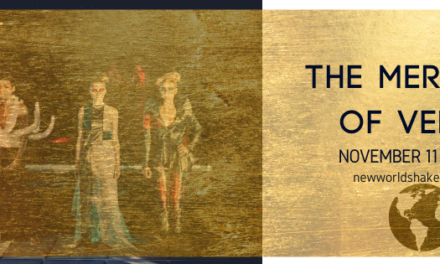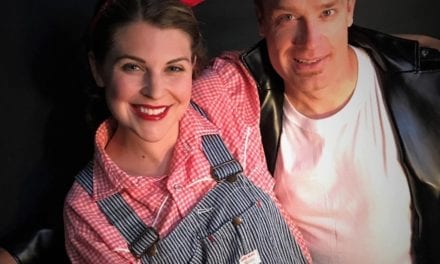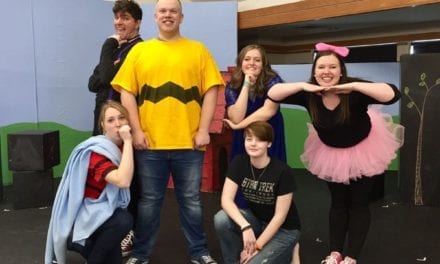
Ben Charles (left) as Puck and
CEDAR CITY — I would first like to say, what a privilege it is that my first review for Utah Theater Bloggers Association is on a Utah Shakespeare Festival production. This production was directed by none other than festival’s creator, Fred Adams. His return to directing is for the celebration of the festival’s fiftieth year. The buzz and excitement of the night’s festivities was certainly in the air during opening night of A Midsummer Night’s Dream.
The night began with a half hour presentation commemorating the festival’s fiftieth year. They had members of the first performance in 1962 come forward to the front of the stage. I can only imagine the joy and pride that group must have felt to see what their efforts many years ago has now turned into. They honored the men whose efforts have made the festival what it is today, especially Fred Adams and R. Scott Phillips. They also had the current members of the festival come into the theater, filling the entire stage plus all the aisles. It was interesting to see how far the festival has come with the very first group of members standing with the current members. It was a very inspiring and heart-warming moment. Too bad they can’t do that every performance because it put the audience in a good mood and prepared them for a great show.
It is force of habit for me to look for a theme (what the director is trying to say) in a production. I also look for a concept (how the director presents theme). For this play finding the theme and concept was difficult. I first thought the theme was that being in love causes you to lose your heart. Throughout the first act, various actors would lose their sleeves, accidently taken by the one that loves them, and thus referencing the saying (which was coined by Shakespeare) of wearing your heart on your sleeve. Since it only happened at the beginning and was only supported by those brief moments, I had to move on and look for a different theme. This search for the theme and concept went on for a while until I became aware that I was more caught up in the story and action of the show. I found myself being more entertained, rather than taught. The first and main purpose of theater is to entertain. Fred Adams is not trying to teach about love, lust, or fairies with this production. He wants the audience to forget about life, and just laugh and be entertained.
The visual aspects were impressive. The set (designed by Bill Forrester) consisted of a large wall of weeping willow-like branches that the actors would use for entrances and exits. The show began with children peering out from behind these vines at different levels. These children played the part of the fairies for Oberon and Titania. The use of children in this way was ingenious because it established at the very beginning a mystical and spritely feel to the show. The lighting (designed by Donna Ruzika) enhanced and progressed the emotions established by the set. Every time a character mentioned “dreaming,” the lights would change to a rosy white light that created a misty look to the stage; almost a drowsy dreamy effect. It seemed to emphasized Puck’s last speech when he says, “. . . you have but slumber’d here while these visions did appear” (Act V. Scene 1).
The acting was at a high level that you would expect for the Utah Shakespeare Festival. As usual the troupe of actors or mechanicals were stand outs. What was unique to this production was that each mechanical had a specific accent which heightened the randomness of this ragtag group of men coming together to create a play. Performances that stood out were Rhett Guter (Flute), Daniel José Molina (Starveling), and of course Max Robinson (Bottom). However, The scene of Bottom’s appearance as a donkey while the mechanicals were practicing in the woods did not seem to fit the rest of the play. The first initial reaction of terror was great. The men were running offstage in fear while being terrorized by Puck and his cronies, but then they came running back on for what seemed to be the purpose of retrieving their props. It felt very unnatural and forced to have them come back on. It broke up the flow and pace of the scene.
Another group of outstanding performers was the four lovers played by Matt Mueller (Lysander), AJ Smithey (Demetrius), Betsy Mugavero (Hermia), and Bri Sudia (Helena). I would like to especially highlight Sudia’s performance. She played Helena with a desperation and longing for love that made her choice to tell Demetrius about Lysander and Hermia’s flight seem natural and understandable. Sudia gave us a tender moment when Demetrius (Smithey) declares his love for Helena to the Duke. The ineffable look of joy on her face at that moment was heartwarming and touching. That feeling of finally being loved by the one you love was very relatable and Sudia did a masterful job at conveying it.
Overall this production was fabulous. I laughed so hard my face hurt. Puck (Ben Charles) had a Peter Pan quality that was charming and lively. The use of the lawn outside of the theater added to the intensity and humor of the lovers’ chase. The modern tone and inflection sometimes used by Helena (Bri Sudia) and Hermia (Betsy Mugavero) was refreshing and very amusing. It was a wonderful night of theater.
Before the play began a quote by Fred Adams was read, “Our actors are here to serve.” This is a very true statement for all the actors and crew involved with A Midsummer Night’s Dream. This production is a testament to the fine work Utah Shakespeare Festival has done these past 50 years. Come see A Midsummer Night’s Dream and forget about life for a while.
Update: Read UTBA’s interview of Betsy Mugavero (Hermia) and Matt Mueller (Lysander). We also invite you to watch UTBA’s video interview of the Utah Shakespeare Festival’s executive director, R. Scott Phillips.

Kymberly Mellen (left) as Titania and Max Robinson as Nick Bottom in the Utah Shakespeare Festival’s 2011 production of A Midsummer Night’s Dream. (Copyright Utah Shakespeare Festival. Photo by Karl Hugh.)




